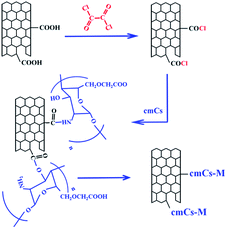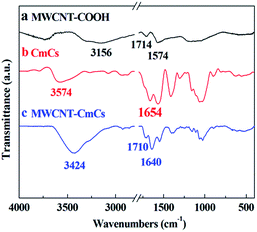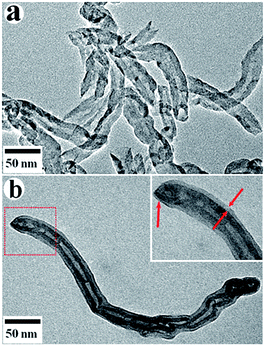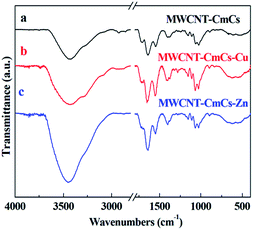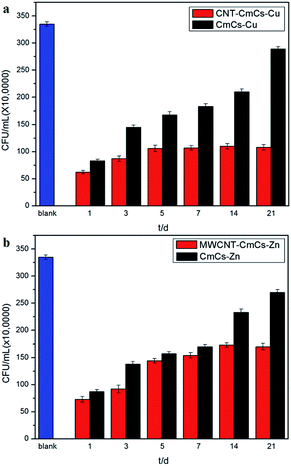Metal ion-coordinated carboxymethylated chitosan grafted carbon nanotubes with enhanced antibacterial properties†
Xiangping Hao,
Shougang Chen*,
Hui Yu,
Dan Liu and
Weixiang Sun
Institute of Materials Science and Engineering, Ocean University of China, Qingdao 266100, PR China. E-mail: sgchen@ouc.edu.cn; Fax: +86-0532-66781688; Tel: +86-0532-66781688
First published on 11th December 2015
Abstract
Covalent bonding of multiwalled carbon nanotubes (MWCNTs) with carboxymethyl chitosan (CmCs) was prepared by the grafting method. The reaction products were confirmed by Fourier transform infrared spectroscopy (FTIR). The transmission electron microscopy (TEM) images and the thermogravimetric analysis (TGA) showed that the MWCNTs were coated by the CmCs uniformly, and the solubility and stability of the composites also increased in dimethyl sulfoxide (DMSO) and aqueous solutions. Multiwalled carbon nanotubes (MWCNTs) with carboxymethyl chitosan (CmCs) composites have been prepared in this work. It has been found that MWCNTs were coated by the CmCs uniformly and the solubility and stability of the composites also increased in dimethyl sulfoxide (DMSO) and aqueous solutions. The Cu and Zn ions were further coordinated to the MWCNT–CmCs composites. The MWCNT–CmCs metal complex showed a slower release rate than the CmCs metal complex by conductivity measurements. The results have confirmed the coordinated MWCNT–CmCs exhibited excellent antibacterial activity against Staphylococcus aureus (S. aureus), Escherichia coli (E. coli) and Vibrio anguillarum. The susceptibility of MWCNT–CmCs–Cu against bacteria was more pronounced than that of MWCNT–CmCs–Zn, and all the complex materials illustrated more excellent antibacterial ability for S. aureus. The MWCNT–CmCs metals complex still illustrated good antibacterial property against S. aureus after 21 days. These results hinted that the composites possess great potential to be an alternative to other antifouling agents.
1. Introduction
Trisubstituted organotin compounds (OTCs) have been widely used in antifouling paint in the marine industry since 1950s because of their highly efficient biocidal properties.1,2 However, the severe side-effect of OTCs on marine organisms has been regularly reported.3,4 More and more investigators5–8 confirmed that the OTCs have severe negative effects, such as shell thickening, growth anomalies in oysters and reduction of growth in mussels. Hence, the application of antifouling paint containing OTCs had been suggested to be prohibited from use from 1st January 2008. It is therefore necessary to investigate new environmentally friendly antifouling materials. Cu-base and Zn-base antifouling products are now receiving considerable attentions.9–14 However, the long-term antibacterial performance was reported to be inferior due to the fast metal release during service and further improvement is needed.9,12,13How to decrease the release rate of antifoulant under the condition of increasing and/or retaining the antifouling properties is an important issue. The carbon nanotubes (CNTs) caught our attention for its unique structure. In previous studies, the CNTs had been used in antifouling coatings, which obviously reduce the adhesion of algae and barnacles.15 In addition, incorporation of CNTs to the complex materials has been found to improve the stiffness and strength of coatings.16 Various polymers including polystyrene,17,18 poly(vinyl alcohol),19 poly(styrene sulfonate),20 poly(phenylacetylene),21 polyacetylene22 and poly(butyl methacrylate)23 were used to improve the dispersity ability of CNTs. However, most of polymers are derivatives of limited fossil resources or nonrenewable resources, which are hazardous or unfriendly to the environment. Chitosan, with one amino group and two hydroxyl groups, the deacetylated product of chitin, is the second most abundant natural biopolymer on the earth.24 It is one type of nontoxic polymer, which contains the properties of biodegradability and biocompatibility.25,26
In this article, the MWCNTs-grafted carboxymethylated chitosan (CmCs) composites which possessed excellent solubility and stability both in DMSO and aqueous solution were covalently synthesized. The metal ions (Cu2+, Zn2+) were coordinated with CmCs by the amino and hydroxyl groups.27–29 The experimental results also exhibited the complex materials had admirable antibacterial properties for S. aureus, E. coli and Vibrio anguillarum. At the same time, we found the release rate of metal ions is obviously slower than CmCs–metal complex materials by the conductivity measurement, and we studied the long-term antibacterial activity of MWCNT–CmCs–metal for S. aureus. Since the bacteria plays the most important role in the process of marine fouling, the new composites could provide promising applications in environment-friendly antifouling technology.
2. Experimental
2.1 Materials
Carboxyl MWCNTs (MWCNT–COOH) were purchased from Shenzhen Nanotech Port Co. (Shenzhen, China) with a diameter of 20–40 nm, length < 5 μm and the purity > 97%. Carboxymethyl chitosan CmCs was provided by Meilun Biotech Co. Ltd (Dalian, China) with its average molecular weight (MW) of 105. Dimethylformamide was processed with molecular sieve for 24 hours, followed by vacuum distillation. S. aureus, E. coli and Vibrio anguillarum were purchased from Rishui Biotech Co. Ltd (Qingdao, China).2.2 Synthesis of MWCNT–CmCs
To modify MWCNTs with CmCs, carboxyl groups of MWCNT–COOH were converted into acyl chloride groups due to the low reaction activity.30 The MWCNT–COCl could further react with amine and hydroxyl groups of CmCs. The reaction process is illustrated in Fig. 1.The MWCNT–COOH (30 mg) was suspended in anhydrous dimethylformamide (DMF, 20 mL) with the ultrasonic treatment for 20 min. Then 1 mL of oxalyl chloride was added dropwise to the suspension of MWCNT–COOH with stirring at around 0 °C to 4 °C under nitrogen atmosphere. The suspension was stirred for 2 h and then for another 2 h at room temperature. The excess oxalyl chloride was eliminated by raising the temperature to 70 °C. Then, 300 mg of CmCs dispersed in anhydrous DMF (20 mL) was added to the previous mixture solution, followed by stirring at 110 °C for 48 h. After the reaction, the solid sediment was separated by centrifugation, and the solid was washed thoroughly with deionized water, filtered through a 0.22 μm microporous membrane repeatedly, and washed with ethanol (85%) and anhydrous ethanol in turn. Finally, the product obtained from the membrane was dried under vacuum.
2.3 Synthesis of MWCNT–CmCs metal complex
Excessive metal ions (Cu2+, Zn2+) were added into the MWCNT–CmCs solution with stirring at room temperature. After 24 h stirring, the mixed solution was filtered through a 0.22 μm microporous membrane and washed with deionized water repeatedly until no metal ions could be detected by Na2S. Ultimately, the sample was washed with ethanol (85%) and anhydrous ethanol, and then dried under vacuum.2.4 Characterizations
Fourier transforms infrared spectroscopy FTIR spectra were recorded on a Bruker TENSOR 27 spectrometer (Bruker, Germany) with KBr discs. Transmission electron microscopy TEM images for MWCNT–COOH and MWCNT–CmCs were observed by Hitachi H-700 transmission electron microscope (Hitachi, Japan). Thermo gravimetric analysis (TGA) was measured by the TGA/STDA851e thermal analyzer (Mettler-Toledo, Switzerland). Conductivity properties were measured by the DDS-307 conductivity meter (Hongyi, China) with cell constant equal to 9.80 unit.2.5 Antibacterial test
The antibacterial performance of MWCNT–CmCs metal complex against E. coli, S. aureus and Vibrio anguillarum was studied by the colony counting method. The mixture was incubated with continuous shaking at 37 °C for 12 h, and the cells were counted with a blood counting chamber.Longer culturing period was evaluated by MWCNT–CmCs–Cu and MWCNT–CmCs–Zn inhibited for S. aureus. The samples were shaking in phosphate buffered saline (PBS, 0.1 M, pH7.4) solution after 1 day, 3 days, 5 days, 7 days, 14 days and 21 days, respectively. After that, the mixed solution was filtered through a 0.22 μm microporous membrane and washed with deionized water repeatedly until no metal ions could be detected by Na2S. Ultimately, the sample was washed with ethanol (85%) and anhydrous ethanol, and then dried under vacuum. The antibacterial test was same as above descriptions.
3. Results and discussion
3.1 Characterization of MWCNT–CmCs
Fig. 2 shows the FTIR spectra of the prepared MWCNT–CmCs samples. It can be seen from the MWCNTs spectrum that the broad absorption peaks at 3156 cm−1 and 1714 cm−1 can be associated with the O–H stretching vibration and the C![[double bond, length as m-dash]](https://www.rsc.org/images/entities/char_e001.gif) O stretching vibration, respectively. The strong band at 1574 cm−1 is assigned to the –C
O stretching vibration, respectively. The strong band at 1574 cm−1 is assigned to the –C![[double bond, length as m-dash]](https://www.rsc.org/images/entities/char_e001.gif) C– stretching vibration of MWCNTs.31,32 The spectrum of MWCNT–CmCs is quite different from MWCNT–COOH, but similar to the CmCs, implying the attachment of CmCs to MWCNTs. More importantly, the absorption peak of C
C– stretching vibration of MWCNTs.31,32 The spectrum of MWCNT–CmCs is quite different from MWCNT–COOH, but similar to the CmCs, implying the attachment of CmCs to MWCNTs. More importantly, the absorption peak of C![[double bond, length as m-dash]](https://www.rsc.org/images/entities/char_e001.gif) O stretching at 1664 cm−1 (Fig. 2(b)) shifts to 1640 cm−1 (Fig. 2(c)), which indicates that the –COOH of MWCNTs had reacted with the –NH2 of CmCs and the –NHCO– group had been formed. In addition, the weak peak at 1710 cm−1 (Fig. 2(c)), ascribing to the ester (–COO–) band, suggests the reaction between –COOH of MWCNTs and –OH of CmCs.33 Furthermore, the broad band assigned to O–H and N–H of CmCs at 3574 cm−1 (Fig. 2(b)) shifting to 3424 cm−1 (Fig. 2(c)) which was associated to N–H stretching of acylamino, and that is also consistent with the above descriptions.
O stretching at 1664 cm−1 (Fig. 2(b)) shifts to 1640 cm−1 (Fig. 2(c)), which indicates that the –COOH of MWCNTs had reacted with the –NH2 of CmCs and the –NHCO– group had been formed. In addition, the weak peak at 1710 cm−1 (Fig. 2(c)), ascribing to the ester (–COO–) band, suggests the reaction between –COOH of MWCNTs and –OH of CmCs.33 Furthermore, the broad band assigned to O–H and N–H of CmCs at 3574 cm−1 (Fig. 2(b)) shifting to 3424 cm−1 (Fig. 2(c)) which was associated to N–H stretching of acylamino, and that is also consistent with the above descriptions.
The TEM images of the MWCNT–CmCs samples were exhibited in Fig. 3. For MWCNT–COOH sample, there is no extra phase existed because of the smooth wall and opened tips (Fig. 3(a)). However, an extra organic layer for the MWCNTs could be observed from MWCNT–CmCs (Fig. 3(b)) since the covalent reaction between MWCNT and CmCs. The reaction mainly occurred both at the tips and on the whole surface of MWCNTs. Due to the existence of the polymer layers, the dispersion ability of MWCNT–CmCs was remarkably improved in aqueous solution and DMSO, and the solution can be stored stably for 5 months (Fig. S1†) compared with MWCNTs. In addition, the thermostability of MWCNT–CmCs was extraordinarily good under 261 °C by TGA curves (Fig. S2†), which make it possible to be applied in setting of high temperature.
3.2 Characterization of MWCNT–CmCs–metal complex
The FTIR spectra of the MWCNT–CmCs–metal complex have been shown in Fig. 4. Compared with MWCNT–CmCs (Fig. 4(a)), the non-symmetric stretching vibration peak of C![[double bond, length as m-dash]](https://www.rsc.org/images/entities/char_e001.gif) O at 1640 cm−1, shifts to higher wave numbers at 1653 cm−1 in MWCNT–CmCs–Cu (Fig. 4(b)) and 1645 cm−1 in MWCNT–CmCs–Zn (Fig. 4(c)). Correspondingly, the symmetric stretching vibration at 1400 cm−1 for C
O at 1640 cm−1, shifts to higher wave numbers at 1653 cm−1 in MWCNT–CmCs–Cu (Fig. 4(b)) and 1645 cm−1 in MWCNT–CmCs–Zn (Fig. 4(c)). Correspondingly, the symmetric stretching vibration at 1400 cm−1 for C![[double bond, length as m-dash]](https://www.rsc.org/images/entities/char_e001.gif) O peak in Fig. 4(a) shifts to the 1406 cm−1 and 1403 cm−1 in Fig. 6(b) and 4(c), respectively. This observation could be ascribed to the coordination carboxyl groups between MWCNT–CmCs and metal ions, and the strong covalent ability of O–M causing an increase of distance of different C
O peak in Fig. 4(a) shifts to the 1406 cm−1 and 1403 cm−1 in Fig. 6(b) and 4(c), respectively. This observation could be ascribed to the coordination carboxyl groups between MWCNT–CmCs and metal ions, and the strong covalent ability of O–M causing an increase of distance of different C![[double bond, length as m-dash]](https://www.rsc.org/images/entities/char_e001.gif) O bands. In addition, the new adsorption peaks have also been found: peak at 624 cm−1 in Fig. 4(b) and 620 cm−1 in Fig. 4(c), which could be ascribed to the stretching vibration of O–Cu and O–Zn based on the previous results.34 It should be noted that the band at 3424 cm−1 in Fig. 4(a) shifts to 3434 cm−1 in Fig. 4(b) and to 3449 cm−1 in Fig. 4(c), implying the unreacted amino and hydroxyl of MWCNT–CmCs have been involved in the adsorption.
O bands. In addition, the new adsorption peaks have also been found: peak at 624 cm−1 in Fig. 4(b) and 620 cm−1 in Fig. 4(c), which could be ascribed to the stretching vibration of O–Cu and O–Zn based on the previous results.34 It should be noted that the band at 3424 cm−1 in Fig. 4(a) shifts to 3434 cm−1 in Fig. 4(b) and to 3449 cm−1 in Fig. 4(c), implying the unreacted amino and hydroxyl of MWCNT–CmCs have been involved in the adsorption.
3.3 Evaluation of antibacterial properties
The colony counting method was used to quantitative analysis of antibacterial performance (Fig. 5). The different bacteria solutions containing MWCNT–CmCs, CmCs–Zn, CmCs–Cu, MWCNT–CmCs–Zn and MWCNT–CmCs–Cu, respectively, were counted with a blood counting chamber after incubated for 12 h at 37 °C. Compared with the blank control group, the bacteria concentrations for MWCNT–CmCs, CmCs–Zn, CmCs–Cu, MWCNT–CmCs–Zn and MWCNT–CmCs–Cu decreased to 34%, 21%, 16%, 12% and 8% against S. aureus, respectively, for E. coli, the bacteria concentrations decreased to 50%, 24%, 20%, 16%, 11%, and for Vibrio anguillarum, the bacteria concentration decreased to 62%, 27%, 25%, 20%, and 15%, respectively. From these results, the antibacterial performance of MWCNT–CmCs–Cu is better than other complex materials. Moreover, all the complex materials show more excellent antibacterial ability for S. aureus based on the reduced value of bacteria concentrations. S. aureus which is Gram positive bacterial, have thicker cell wall composed of high concentration peptidoglycan and teichoic acid, and these polymers take a large number of negative charges functional groups with the trend of the strong absorption of metal cation. Whereas, E. coli and Vibrio anguillarum are Gram negative bacterial, and this kind of bacterial cell wall contained lower concentration of peptidoglycan and teichoic acid as a result of restriction on metal ions adsorption.35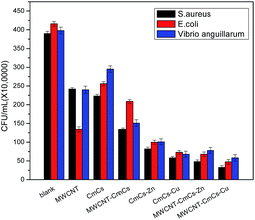 | ||
| Fig. 5 Comparison of the bacteria concentrations in Luria-Bertani medium containing MWCNT–CmCs, CmCs–Zn, CmCs–Cu, MWCNT–CmCs–Zn and MWCNT–CmCs–Cu. | ||
3.4 Evaluation the release rate of metal ions
The release rate of metal ions could obviously affect the long-term antibacterial performance and service life. In order to evaluate the release rate of metal ions, the same concentration of four-group composite solutions were prepared. As metal ions releasing, the conductivity of the solution will continuously increase along with the different immersion time. The conductivity curves for CmCs–Cu, MWCNT–CmCs–Cu, CmCs–Zn, MWCNT–CmCs–Zn were shown in Fig. 6. During the initial days, especially in the first day, the conductivity of CmCs–Cu solution increases sharply, after five days, the release rate of Cu ions increases gently. However, the conductivity of MWCNT–CmCs–Cu solution kept a steadily increase from the 1st day to the 21st day, which indicates that the slower releasing rate for Cu ions comes from after adding of MWCNT. The similar change trend had also been observed for the composites of CmCs–Zn and MWCNT–CmCs–Zn. Due to the presence of MWCNT, the MWCNT–CmCs metal composites show sustained release effect towards metal ions, consequently. It has been reported that the MWCNT can complex with metal ions like Cu2+ and Zn2+ because of the presence of the carboxyl group. In addition, it has been found in this work that the carboxyl group of MWCNTs can covalently react with the amino group of CmCs. The CmCs coated on the surface of the MWCNTs has the ability to adsorb metal ions because of the nitrogen atoms exist. Both of them contribute to the decrease of the release rate of the metal ions.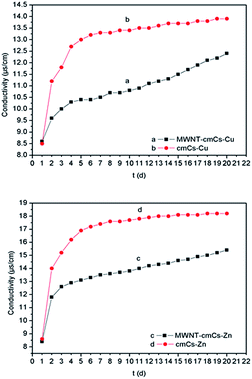 | ||
| Fig. 6 The conductivity curves of (a) MWCNT–CmCs–Cu, (b) CmCs–Cu, (c) MWCNT–CmCs–Zn, (d) CmCs–Zn in deionized water. | ||
3.5 Evaluation of long-term antibacterial properties
Although, compared with MWCNT–CmCs, CmCs–Zn and CmCs–Zn have reasonable antibacterial properties as well, the long-term inhibition for bacteria was disappointed. The result demonstrated in Fig. 7. Long-term inhibition for bacteria was evaluated by MWCNT–CmCs metal complex against for S. aureus. The result expressed that the antibacterial activities of CmCs–metal groups were decreased rapidly. Fig. 7(a) showed the antibacterial property of MWCNT–CmCs–Cu and CmCs–Cu after shaking 1 day, 3 days, 7 days, 14 days and 21 days in PBS, and Fig. 7(b) showed the antibacterial property of MWCNT–CmCs–Zn and CmCs–Zn after shaking different days. It obviously demonstrated that these results were similar with the results of conductivity. During the initial days, the bacteriostasis rete decreased sharply for all of the four groups, but after five days, the bacteriostasis rete of CmCs–Cu and CmCs–Zn still cut down rapidly. Whereas, compared with CmCs metal complex, after five days, the bacteriostasis rate of MWCN–CmCs metal complex became stable. In briefly, the MWCNT–CmCs metal complex expressed good antibacterial activities for a period of time.4. Conclusions
MWCNT–CmCs composites were prepared by covalently grafting CmCs onto the surfaces of MWCNTs. It has been demonstrated by FTIR spectra that the MWCNT–CmCs and MWNCT–CmCs–metal were successfully prepared in this work. The CmCs coated both at the tips and on the whole surface of MWCNTs. The composites MWCNT–CmCs displayed remarkable solubility and stability in DMSO and aqueous solution. The MWCNT–CmCs showed slower release rate of metal ions than CmCs–metal complex since MWCNT exist. The antibacterial properties of the MWCNT–CmCs metal complex studied with S. aureus, E. coli and Vibrio anguillarum. Moreover, the susceptibility of MWCNT–CmCs–Cu against bacteria was more pronounced than that of MWCNT–CmCs–Zn, and all the complex materials illustrated more excellent antibacterial ability for S. aureus. The release rate of metal ions is obviously slower than CmCs–metal complex materials by the conductivity measurement. Corresponding with the results of the conductivity measurement, MWCNT–CmCs–Cu and MWCNT–CmCs–Zn still present good antibacterial property against S. aureus after 21 days. The composites provide promising applications in a wide range of areas represented by the environment-friendly antifouling technology.Acknowledgements
This work was supported by Shandong Province Programs for Science and Technology Development (2013GHY11508), National Natural Science Foundation (51572249) and Natural Science Foundation of Shandong Province (ZR2014EMM021) and Program for New Century Excellent Talents in University (NCET-12-0504).Notes and references
- M. Furdek, M. Vahčič, J. Ščančar, R. Milačič, G. Kniewald and N. Mikac, Mar. Pollut. Bull., 2012, 64, 189–199 CrossRef CAS PubMed.
- M. Hoch, Appl. Geochem., 2001, 16, 719–743 CrossRef CAS.
- Y. C. Song, J. H. Woo, S. H. Park and I. S. Kim, Mar. Pollut. Bull., 2005, 51, 1048–1053 CrossRef CAS PubMed.
- W. E. Pereira, T. L. Wade, F. D. Hostettler and F. Parchaso, Mar. Pollut. Bull., 1999, 38, 1005–1010 CrossRef CAS.
- M. H. Salazar and S. M. Salazar, Mussels as Bioindicators: Effects of TBT on Survival, Bioaccumulation, and Growth Under Natural Conditions, Organotin, 1996, 306–330 Search PubMed.
- M. A. Champ and P. F. Seligman, An Introduction to Organotin Compounds and Their Use in Antifouling Coatings, Organotin, 1996, 1–25 CAS.
- M. Hoch, Appl. Geochem., 2001, 16, 719–743 CrossRef CAS.
- K. Fent and W. A. Meier, Arch. Environ. Contam. Toxicol., 1992, 22, 428–438 CrossRef CAS PubMed.
- N. Singh and A. Turner, Mar. Pollut. Bull., 2009, 58, 559–564 CrossRef CAS PubMed.
- S. Kant, S. Kalia and A. Kumar, J. Alloys Compd., 2013, 578, 249–256 CrossRef CAS.
- S. D. W. Comber, M. J. Gardner and A. B. Boxall, J. Environ. Monit., 2002, 4, 417–425 RSC.
- A. Turner, Mar. Pollut. Bull., 2010, 60, 159–171 CrossRef CAS PubMed.
- L. Holmes and A. Turner, Environ. Pollut., 2009, 157, 3440–3444 CrossRef CAS PubMed.
- E. Ytreberg, J. Karlsson and B. Eklund, Sci. Total Environ., 2010, 408, 2459–2466 CrossRef CAS PubMed.
- A. Beigbeder, P. Degee, S. L. Conlan, R. J. Mutton, A. S. Clare, M. E. Pettitt, M. E. Callow, J. A. Callow and P. Dubois, Biofouling, 2008, 24, 291–302 CrossRef PubMed.
- C. R. Bradbury, J. K. Gomon, L. Kollo, H. Kwon and M. Leparoux, J. Alloys Compd., 2014, 585, 362–367 CrossRef CAS.
- D. E. Hill, Y. Lin, A. M. Rao, L. F. Allard and Y. P. Sun, Macromolecules, 2002, 35, 9466–9471 CrossRef CAS.
- C. A. Mitchell, J. L. Bahr, S. Arepalli, J. M. Tour and R. Krishnamoorti, Macromolecules, 2002, 35, 8825–8830 CrossRef CAS.
- Y. Lin, B. Zhou, K. A. S. Fernando, P. Liu, L. F. Allard and Y. P. Sun, Macromolecules, 2003, 36, 7199–7204 CrossRef CAS.
- M. J. O'Connell, P. Boul, L. M. Ericson, C. Huffman, Y. Wang, E. Haroz, C. Kuper, J. Tour, K. D. Ausman and R. E. Smalley, Chem. Phys. Lett., 2001, 342, 265–271 CrossRef.
- B. Z. Tang and H. Xu, Macromolecules, 1999, 32, 2569–2576 CrossRef CAS.
- B. C. Ku, D. Y. Kim, J. S. Lee, A. Blumstein, J. Kumar and L. A. Samuelson, Polym. Compos., 2009, 30, 1817–1824 CrossRef CAS.
- W. H. Li, X. H. Chen, C. S. Chen, L. S. Xu, Z. Yang and Y. G. Wang, Polym. Compos., 2008, 29, 972–977 CrossRef CAS.
- A. Altınışık, Y. Seki and K. Yurdakoc, Polym. Compos., 2009, 30, 1035–1042 CrossRef.
- D. W. Jenkins and S. M. Hudson, Chem. Rev., 2001, 101, 3245–3273 CrossRef CAS PubMed.
- P. Carlos, A. M. Waldo, P. Hazel and A. Niuris, Macromol. Biosci., 2003, 3, 511–520 CrossRef.
- R. S. Juang and H. J. Shao, Water Res., 2002, 36, 2999–3008 CrossRef CAS PubMed.
- K. H. Chu, J. Hazard. Mater., 2002, 90, 77–95 CrossRef CAS PubMed.
- E. Guiba, Sep. Purif. Technol., 2004, 38, 43–74 CrossRef.
- F. Pompeo and D. E. Resasco, Nano Lett., 2002, 2, 369–373 CrossRef CAS.
- J. Zhang, H. Zou, Q. Qing, Y. Yang, Q. Li, Z. Liu, X. Guo and Z. Du, J. Phys. Chem., 2003, 107, 3712–3718 CrossRef CAS.
- P. C. Eklund, J. M. Holden and R. A. Jishi, Carbon, 1995, 33, 959–972 CrossRef CAS.
- Z. Wu, W. Feng, Y. Feng, Q. Liu, X. Xu, T. Sekino, A. Fujii and M. Ozaki, Carbon, 2007, 45, 1212–1218 CrossRef CAS.
- S. Sun and A. Wang, React. Funct. Polym., 2006, 66, 819–826 CrossRef CAS.
- T. J. Beveridge, Annu. Rev. Microbiol., 1989, 43, 147–171 CrossRef CAS PubMed.
Footnote |
| † Electronic supplementary information (ESI) available. See DOI: 10.1039/c5ra21003h |
| This journal is © The Royal Society of Chemistry 2016 |

